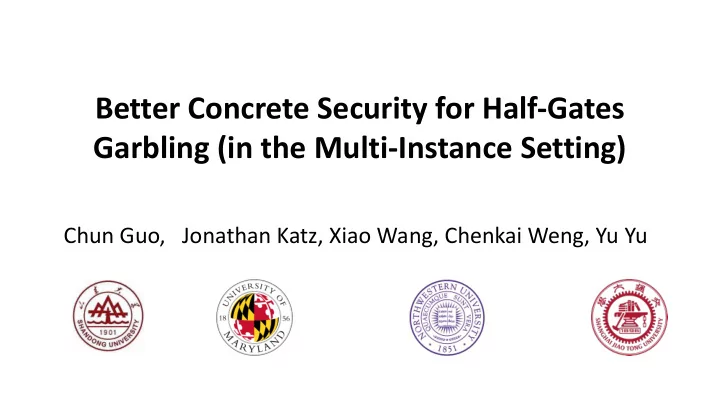

Better Concrete Security for Half-Gates Garbling (in the Multi-Instance Setting) Chun Guo, Jonathan Katz, Xiao Wang, Chenkai Weng, Yu Yu
All widely used GCs have a birthday-bound security Explicit attack • GC based on fix-key block cipher -> O(tC/2 n ) 267 machine-month to break a GC with 80-bit labels, ~~ 3500$ • Those based on standard PRFs: C hybrids in the proof, each No proof with optimal with a PRF game -> O(tC/2 n ) security (but also no attack) • Exceptions: some RO based protocols Slow
Attack in the multi-instance setting • An adversary, with n garbled circuits (each garbled independently ), can break one of them with probability ~tC/2 n – t: running time – C: sum of all circuit sizes • In means that switching free-XOR Delta does NOT help!
Our New Abstraction for better security • A weaker version of Tweakable correlation robust hash – Tweakable, but there is a explicit bound how frequently each tweak will be used. – Bound = 2 for Garbling and OT extension. • Hash function H is secure if F k (x, i) = H(k Å x, i) is a pseudorandom function with a bounded-query adversary.
Construction • TMMO(x, i) = E i (σ(x)) Å σ(x) – Friendly to batch – σ(x) is orthomorphism if σ(x) and σ(x) Å x are all permutations • Proven secure if E is an ideal cipher – Adv’s advantage is bounded by O(u(p+q)/2 n ), where u is maximum number of oracle calls for any tweak
Practical performance Improved to 24 since then
Implementation suggestion • Always use TMMO regardless of semi-honest or malicious security • Always randomize the start point of the tweak • Code?
Recommend
More recommend